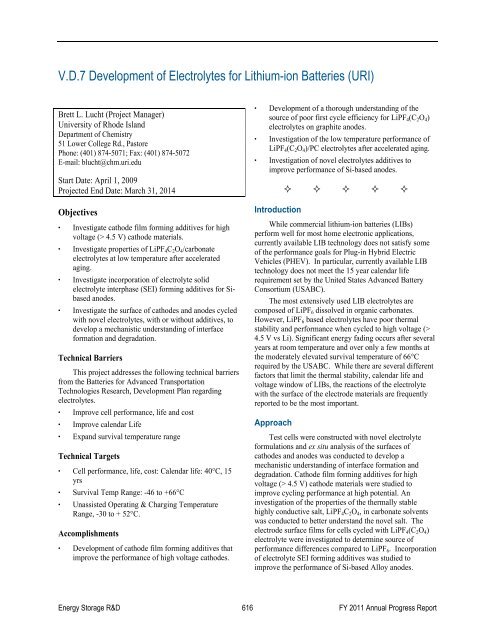V. Focused Fundamental Research - EERE - U.S. Department of ...
V. Focused Fundamental Research - EERE - U.S. Department of ...
V. Focused Fundamental Research - EERE - U.S. Department of ...
Create successful ePaper yourself
Turn your PDF publications into a flip-book with our unique Google optimized e-Paper software.
V.D.7 Development <strong>of</strong> Electrolytes for Lithium-ion Batteries (URI) <br />
Brett L. Lucht (Project Manager)<br />
University <strong>of</strong> Rhode Island<br />
<strong>Department</strong> <strong>of</strong> Chemistry<br />
51 Lower College Rd., Pastore<br />
Phone: (401) 874-5071; Fax: (401) 874-5072<br />
E-mail: blucht@chm.uri.edu<br />
Start Date: April 1, 2009<br />
Projected End Date: March 31, 2014<br />
Objectives<br />
· Investigate cathode film forming additives for high<br />
voltage (> 4.5 V) cathode materials.<br />
· Investigate properties <strong>of</strong> LiPF 4 C 2 O 4 /carbonate<br />
electrolytes at low temperature after accelerated<br />
aging.<br />
· Investigate incorporation <strong>of</strong> electrolyte solid<br />
electrolyte interphase (SEI) forming additives for Sibased<br />
anodes.<br />
· Investigate the surface <strong>of</strong> cathodes and anodes cycled<br />
with novel electrolytes, with or without additives, to<br />
develop a mechanistic understanding <strong>of</strong> interface<br />
formation and degradation.<br />
Technical Barriers<br />
This project addresses the following technical barriers<br />
from the Batteries for Advanced Transportation<br />
Technologies <strong>Research</strong>, Development Plan regarding<br />
electrolytes.<br />
· Improve cell performance, life and cost<br />
· Improve calendar Life<br />
· Expand survival temperature range<br />
Technical Targets<br />
· Cell performance, life, cost: Calendar life: 40°C, 15<br />
yrs<br />
· Survival Temp Range: -46 to +66°C<br />
· Unassisted Operating & Charging Temperature<br />
Range, -30 to + 52°C.<br />
Accomplishments<br />
· Development <strong>of</strong> cathode film forming additives that<br />
improve the performance <strong>of</strong> high voltage cathodes.<br />
· Development <strong>of</strong> a thorough understanding <strong>of</strong> the<br />
source <strong>of</strong> poor first cycle efficiency for LiPF 4 (C 2 O 4 )<br />
electrolytes on graphite anodes.<br />
· Investigation <strong>of</strong> the low temperature performance <strong>of</strong><br />
LiPF 4 (C 2 O 4 )/PC electrolytes after accelerated aging.<br />
· Investigation <strong>of</strong> novel electrolytes additives to<br />
improve performance <strong>of</strong> Si-based anodes.<br />
Introduction<br />
<br />
While commercial lithium-ion batteries (LIBs)<br />
perform well for most home electronic applications,<br />
currently available LIB technology does not satisfy some<br />
<strong>of</strong> the performance goals for Plug-in Hybrid Electric<br />
Vehicles (PHEV). In particular, currently available LIB<br />
technology does not meet the 15 year calendar life<br />
requirement set by the United States Advanced Battery<br />
Consortium (USABC).<br />
The most extensively used LIB electrolytes are<br />
composed <strong>of</strong> LiPF 6 dissolved in organic carbonates.<br />
However, LiPF 6 based electrolytes have poor thermal<br />
stability and performance when cycled to high voltage (><br />
4.5 V vs Li). Significant energy fading occurs after several<br />
years at room temperature and over only a few months at<br />
the moderately elevated survival temperature <strong>of</strong> 66°C<br />
required by the USABC. While there are several different<br />
factors that limit the thermal stability, calendar life and<br />
voltage window <strong>of</strong> LIBs, the reactions <strong>of</strong> the electrolyte<br />
with the surface <strong>of</strong> the electrode materials are frequently<br />
reported to be the most important.<br />
Approach<br />
Test cells were constructed with novel electrolyte<br />
formulations and ex situ analysis <strong>of</strong> the surfaces <strong>of</strong><br />
cathodes and anodes was conducted to develop a<br />
mechanistic understanding <strong>of</strong> interface formation and<br />
degradation. Cathode film forming additives for high<br />
voltage (> 4.5 V) cathode materials were studied to<br />
improve cycling performance at high potential. An<br />
investigation <strong>of</strong> the properties <strong>of</strong> the thermally stable<br />
highly conductive salt, LiPF 4 C 2 O 4 , in carbonate solvents<br />
was conducted to better understand the novel salt. The<br />
electrode surface films for cells cycled with LiPF 4 (C 2 O 4 )<br />
electrolyte were investigated to determine source <strong>of</strong><br />
performance differences compared to LiPF 6 . Incorporation<br />
<strong>of</strong> electrolyte SEI forming additives was studied to<br />
improve the performance <strong>of</strong> Si-based Alloy anodes.<br />
Energy Storage R&D 616 FY 2011 Annual Progress Report



